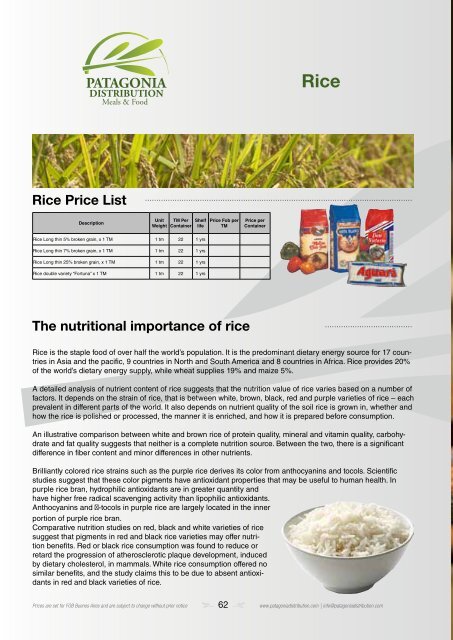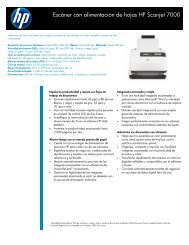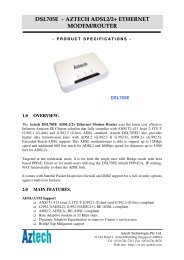You also want an ePaper? Increase the reach of your titles
YUMPU automatically turns print PDFs into web optimized ePapers that Google loves.
PATAGONIA<br />
DISTRIBUTION<br />
Meals & Food<br />
Rice<br />
Rice Price List<br />
Description<br />
Unit<br />
Weight<br />
TM Per<br />
Container<br />
Shelf<br />
life<br />
Price Fob per<br />
TM<br />
Price per<br />
Container<br />
Rice Long thin 5% broken grain, x 1 TM 1 tm 22 1 yrs<br />
Rice Long thin 7% broken grain, x 1 TM 1 tm 22 1 yrs<br />
Rice Long thin 25% broken grain, x 1 TM 1 tm 22 1 yrs<br />
Rice double variety “Fortuna” x 1 TM 1 tm 22 1 yrs<br />
The nutritional importance of rice<br />
Rice is the staple food of over half the world’s population. It is the predominant dietary energy source for 17 countries<br />
in Asia and the pacific, 9 countries in North and South America and 8 countries in Africa. Rice provides 20%<br />
of the world’s dietary energy supply, while wheat supplies 19% and maize 5%.<br />
A detailed analysis of nutrient content of rice suggests that the nutrition value of rice varies based on a number of<br />
factors. It depends on the strain of rice, that is between white, brown, black, red and purple varieties of rice – each<br />
prevalent in different parts of the world. It also depends on nutrient quality of the soil rice is grown in, whether and<br />
how the rice is polished or processed, the manner it is enriched, and how it is prepared before consumption.<br />
An illustrative comparison between white and brown rice of protein quality, mineral and vitamin quality, carbohydrate<br />
and fat quality suggests that neither is a complete nutrition source. Between the two, there is a significant<br />
difference in fiber content and minor differences in other nutrients.<br />
Brilliantly colored rice strains such as the purple rice derives its color from anthocyanins and tocols. Scientific<br />
studies suggest that these color pigments have antioxidant properties that may be useful to human health. In<br />
purple rice bran, hydrophilic antioxidants are in greater quantity and<br />
have higher free radical scavenging activity than lipophilic antioxidants.<br />
Anthocyanins and γ-tocols in purple rice are largely located in the inner<br />
portion of purple rice bran.<br />
Comparative nutrition studies on red, black and white varieties of rice<br />
suggest that pigments in red and black rice varieties may offer nutrition<br />
benefits. Red or black rice consumption was found to reduce or<br />
retard the progression of atherosclerotic plaque development, induced<br />
by dietary cholesterol, in mammals. White rice consumption offered no<br />
similar benefits, and the study claims this to be due to absent antioxidants<br />
in red and black varieties of rice.<br />
Prices are set for FOB Buenos Aires and are subject to change without prior notice<br />
62 www.<strong>patagonia</strong>distribution.com | info@<strong>patagonia</strong>distribution.com






